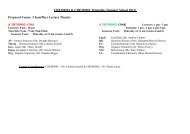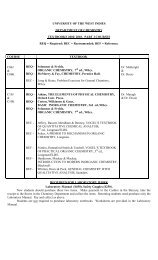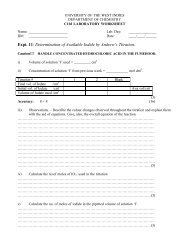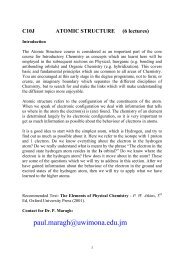O-4 CONDITIONAL ESTIMATION IN AN EXPONENTIAL MODELSmail Mahdi<strong>Department</strong> <strong>of</strong> Computer Science, Mathematics <strong>and</strong> Physics, Cave HillPreliminary test procedure is <strong>of</strong>ten used in statistical inference to fit appropriate models for data sets.In analysis <strong>of</strong> variance, the procedure is used to test whether interactions <strong>of</strong> higher order aresignificant before doing the final inference. In this paper, we present an overview <strong>of</strong> this procedure<strong>and</strong> apply it to estimate the parameters <strong>of</strong> an exponential population. We also present a study on theaccuracy <strong>of</strong> the proposed estimator.O-5 MONGOOSE PREDATION ON ISLAND FAUNA:AN EXPERIMENTAL TEST IN A JAMAICAN DRY FORESTByron S. Wilson <strong>and</strong> Peter Vogel<strong>Department</strong> <strong>of</strong> Life Sciences, MonaAn overriding theme in the extinction <strong>of</strong> isl<strong>and</strong> reptiles is the introduction (by man) <strong>of</strong> potentmammalian predators such as dogs, cats, rats, <strong>and</strong> most notoriously, the Indian mongoose, Herpestesauropunctatus (Pimm, 1986, Case <strong>and</strong> Bolger 1991). Although the evidence for the role <strong>of</strong> themongoose in causing reptile extinctions is largely correlative, it is nevertheless overwhelming(Barbour 1930, Case <strong>and</strong> Bolger 1991). Isl<strong>and</strong> extinctions following the introduction <strong>of</strong> themongoose have been reported frequently, especially in the Caribbean (Case <strong>and</strong> Bolger 1991,Schwartz <strong>and</strong> Henderson 1991, Corke 1992). Besides man, no exotic predator has ever beenimplicated in so many isl<strong>and</strong> extinctions. In Jamaica alone, the mongoose has been associated withthe extinction or near extinction <strong>of</strong> at least two endemic birds <strong>and</strong> four endemic reptiles.Unfortunately, little experimental research effort has been directed at the mongoose issue.Here we describe research aimed at determining the efficacy <strong>of</strong> using mongoose control as a longtermmanagement strategy for preserving biodiversity. Specifically, we outline an experimentalstudy that seeks to determine the community-wide consequences <strong>of</strong> mongoose removal. We haveestablished experimental (=mongoose removal) <strong>and</strong> control (no mongoose removal) plots in theinterior <strong>of</strong> the Hellshire Hills, <strong>and</strong> are currently employing a variety <strong>of</strong> census techniques to study theresponse <strong>of</strong> selected prey species <strong>of</strong> the mongoose. In particular, we are using an extensive series <strong>of</strong>pitfall traps to index the abundance <strong>of</strong> terrestrial species such as lizards, snakes, <strong>and</strong> largearthropods (e.g., arachnids,insects). In addition, we are using survey techniques to estimate the relative abundance <strong>of</strong> theCaribbean ground dove, <strong>and</strong> have established mark-recapture plots to examine the demographicresponse <strong>of</strong> Anolis lizards. Hence, our efforts focus on elucidating the demographic response <strong>of</strong>diverse taxa to the experimental removal <strong>of</strong> a potent exotic predator.In this presentation we will document the effectiveness <strong>of</strong> our mongoose removal program, <strong>and</strong>present some preliminary results concerning the demographic responses <strong>of</strong> targeted species. We alsoreport on some exciting results from our on-going efforts to document biodiversity in the HellshireHills. Specifically, we describe the discovery <strong>of</strong> a population <strong>of</strong> the rare <strong>and</strong> beautiful Jamaicanlizard, the Blue-tailed galliwasp -- known to science from only two specimens -- both collected over50 years ago at Portl<strong>and</strong> Ridge in Clarendon.24
We thus not only document that the species still exists, but also delineate a major range extension forthe species. In addition, we highlight the recent collection <strong>of</strong> two endemic snake species notpreviously recorded from the Hellshire Hills -- the Jamaican boa (or "yellow snake"), <strong>and</strong> a form <strong>of</strong>West Indian dwarf boa (unresolved taxonomically at the time <strong>of</strong> this writing).ReferencesBarbour, T. (1930). Some faunistic changes in the Lesser Antilles. Proc. New Engl<strong>and</strong> Zool. Club.11:73-85.Case, T. J. & D. T. Bolger (1991). <strong>The</strong> role <strong>of</strong> introduced species in shaping the distribution <strong>and</strong>abundance <strong>of</strong> isl<strong>and</strong> reptiles. Evolutionary Ecology 5:272-290.Corke, D. (1992). <strong>The</strong> status <strong>and</strong> conservation needs <strong>of</strong> the terrestrial herpet<strong>of</strong>auna <strong>of</strong> theWindward Isl<strong>and</strong>s (West Indies). Biological Conservation 62:47-58.Pimm, S. L. (1986). Community stability <strong>and</strong> structure. Pages 309-329 in M. E. Soule, editor.Conservation biology: the science <strong>of</strong> scarcity <strong>and</strong> diversity. Sinauer Associates, Inc.Sunderl<strong>and</strong>, Massachusetts, USA.Schwartz, A. & R. W. Henderson (1991). Amphibians <strong>and</strong> reptiles <strong>of</strong> the West Indies:descriptions, distributions, <strong>and</strong> natural history. University <strong>of</strong> Florida Press, Gainesville,Florida, USA.O-6 THE ABUNDANCE AND DISTRIBUTION OF EPIBENTHICBRYOZOANS ON THE ROOTS OF RHIZOPHORA MANGLE INAND AROUND KINGSTON HARBOUR, JAMAICAMarcia Marilyn Chevannes CrearyCentre for Marine Sciences, Mona<strong>The</strong> abundance <strong>and</strong> distribution <strong>of</strong> the bryozoan species on the prop roots <strong>of</strong> the red mangrove,Rhizophore mangle, at diverse locations around Kingston Harbour are described. Specificenvironmental parameters were examined to investigate their relative effects on the pattern <strong>of</strong>abundance <strong>and</strong> distribution observed. <strong>The</strong> study was carried out in four mangrove areas (PortRoyal, Great Salt Pond, Dawkins Pond <strong>and</strong> Hunt's Bay) over a 15 month period between September1994 <strong>and</strong> December 1995 <strong>and</strong> included a total <strong>of</strong> 12 stations.<strong>The</strong> submerged roots <strong>of</strong> some mangrove tree species provide a natural substrate for the attachment<strong>of</strong> a variety <strong>of</strong> sessile organisms including bryozoans. <strong>The</strong> phylum bryozoa is characterized byhaving lophophores <strong>and</strong> are mainly marine colonial organisms forming encrustations or tufts on anassortment <strong>of</strong> substrates. <strong>The</strong>y are found in a variety <strong>of</strong> habitats around Kingston Harbour whichexhibit differing degrees <strong>of</strong> exposure to pollution.This study identified 18 species <strong>of</strong> bryozoa inhabiting the rhizophore community. Diversity wasfound to be highest in Port Royal with 16 species while Hunt's Bay had the lowest diversity havingonly 3 species. Great Salt Pond <strong>and</strong> Dawkins Pond had 8 <strong>and</strong> 3 species respectively.25
- Page 1 and 2: _________________________PROCEEDING
- Page 4 and 5: Monday January 11 th 1999__________
- Page 6 and 7: FREE ORAL PRESENTATIONSChemistry Le
- Page 8 and 9: Wednesday January 13 th , 1999_____
- Page 10 and 11: GEOLOGY____________________________
- Page 12 and 13: POSTER PRESENTATIONSDisplayed in De
- Page 14 and 15: P-20 The compatibility of a thiodan
- Page 16 and 17: P-37 Genetic diversity in dasheens
- Page 18 and 19: P-55 Trinidad clays as a potential
- Page 20 and 21: B. Bark beetles (3 species). The ba
- Page 22 and 23: Figure:Population of adult weevils,
- Page 26 and 27: Six growth forms were observed, all
- Page 28 and 29: The difference in coral cover among
- Page 30 and 31: Examination of whole and sectioned
- Page 32 and 33: Ultimately one of the aims of many
- Page 34 and 35: Table:Concentrations of chlorpyrifo
- Page 36 and 37: Table: Half life of Miral 500CS on
- Page 38 and 39: Nucleotide sequence analysis of the
- Page 40 and 41: Regardless of the level of fertiliz
- Page 42 and 43: Various morphological, physiologica
- Page 44 and 45: O-25 HAIMEA ALTA AND HAIMEA OVUMSER
- Page 46 and 47: A complete thermodynamic descriptio
- Page 48 and 49: One of the promising methods of det
- Page 50 and 51: We aim at producing a model which c
- Page 52 and 53: in comparison to the function f giv
- Page 54 and 55: The scripting language described he
- Page 56 and 57: O-36 CRYPTOGRAPHY AND THE INFORMATI
- Page 58 and 59: ABSTRACTS OF POSTER PRESENTATIONS__
- Page 60 and 61: The varied range of effects to the
- Page 62 and 63: P-5 THE USE OF INFORMATION SYSTEMS
- Page 64 and 65: The present maximum phytoplankton a
- Page 66 and 67: P-9 INDIVIDUAL ZOOPLANKTON SPECIES
- Page 68 and 69: The most abundant crustacean captur
- Page 70 and 71: Potamic characteristics include slu
- Page 72 and 73: Preliminary results have indicated
- Page 74 and 75:
M. tuberculata was found only at tw
- Page 76 and 77:
Thiara granifera is gregarious, pro
- Page 78 and 79:
The population of the CLM in Jamaic
- Page 80 and 81:
The present studies were undertaken
- Page 82 and 83:
P-21 ANTIFEEDANT PROPERTIES OF VARI
- Page 84 and 85:
ReferencesClarke-Harris, D.O. (1998
- Page 86 and 87:
Mansingh, A., Robinson, D.E. and Da
- Page 88 and 89:
P-24 THE NEW JAMAICA SEISMOGRAPH NE
- Page 91 and 92:
P-26 JUPITER LANDSLIDE, RIO GRANDE
- Page 93 and 94:
P-27 BIOSTRATIGRAPHIC INVESTIGATION
- Page 95 and 96:
P-28 EVALUATION OF MEDIA, METHODS O
- Page 97 and 98:
P-31 PHYSIOLOGICAL ECOLOGY OF TEN P
- Page 99 and 100:
2. Stavely, J.R., Steadman, J.R. 19
- Page 101 and 102:
P-36 IDENTIFICATION, DISTRIBUTION,
- Page 103 and 104:
Todd G. A., Daniels M. J. and Callo
- Page 105 and 106:
P-42 QUANTIFICATION AND IDENTIFICAT
- Page 107 and 108:
P-46 A STUDY OF VIBRIO SPECIES IN R
- Page 109 and 110:
P-49 INDOOR LEVELS OF NO2 MEASURED
- Page 111 and 112:
Qualitative assessment of these sig
- Page 113 and 114:
P-55 TRINIDAD CLAYS AS A POTENTIAL
- Page 115 and 116:
The procedure was applied to the Pi
- Page 117:
117










